Tuniq Tower 120: Air Cooling to the Max
by Wesley Fink on January 15, 2007 12:01 AM EST- Posted in
- Cases/Cooling/PSUs
Sunbeam Tuniq Tower 120
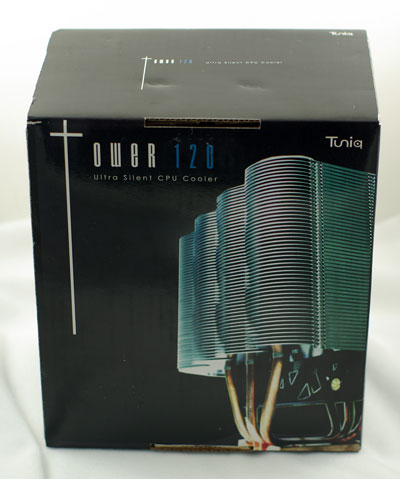
The Tuniq Tower 120 is manufactured by Sunbeam Company, a company based in Taiwan with manufacturing in mainland China. Sunbeamtech was founded in 2000, and the company specializes in PC modding, performance enhancement solutions, and PC cases. Tuniq is a subsidiary of Sunbeam, producing coolers like the Tuniq Tower 120 and specialized PC cases.
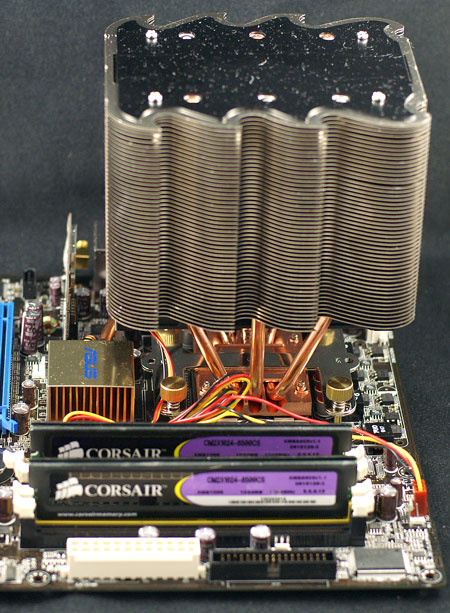
The Tower 120 consists of a massive 120mm 9-blade fan in the core of three closed heatpipe loops cooled with a huge number of thin aluminum fins for heat dissipation. The package comes with the special 9-blade fan, a small tube of high performance thermal grease, a fan controller that can mount in an empty expansion slot, and the adapter plate for Intel Socket 775 or AMD K8 (939/940/754).
The Tuniq is very heavy compared to standard heatsinks, which generally fall in the 400g to 650g weight range. At 798g without the fan you will find the final operating weight of the Tuniq 120 close to a kilogram (2.2 lbs). However, this is in line with coolers that take a similar approach to cooling like the Scythe Infinity.
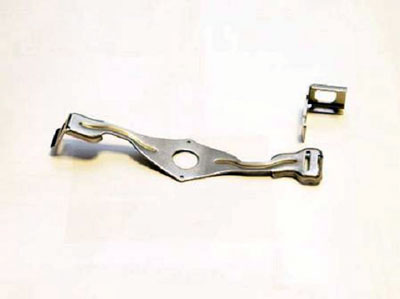
The package does NOT include the adapter for the AMD AM2 processor, but Tuniq tells us the Tower 120 will work on AM2 by using the Zalman ZM-OC1 adapter, which is pictured above. This can be purchased as an accessory from Zalman retailers.
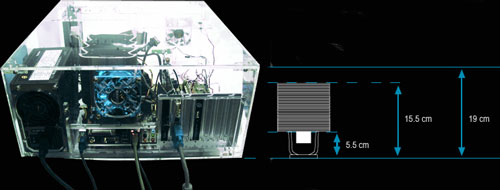
The Tuniq Tower 120 is a massive heatsink, designed to fit mid-tower and full-tower cases. At first glance you may wonder how it could possibly fit in a case, but the height is a bit less than the dimensions of a standard case and the Tuniq will definitely fit a standard case. While the cooler is very large in both width and length it is small at the base. As a result the bulk is above most onboard components around the CPU socket. The bottom line is the Tuniq will fit most motherboards with no problems.
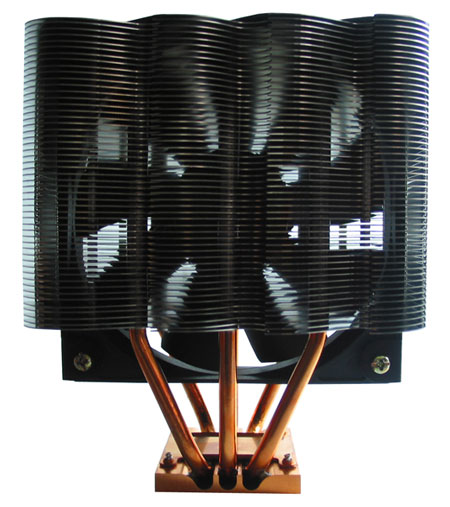
While any 120 mm fan can be used with the Tuniq, the stock fan has 9-blades instead of the more common 7-blade design. This is said to move more air at the same RPM, which allows the fan to be effective at low speeds that are also very quiet. Tuniq strongly encourages that you use the stock fan.

The unit comes standard with a slot-mount fan controller. Specifications indicate the fan dial adjusts fan speed from 1000 to 2000 RPM. These values are very low compared to smaller fans that must run at much higher speeds to be effective. The down-side of higher speed fans is that fan noise normally increases with speed. It is clear Sunbeam chose this huge 120mm fan with 9 blades to reduce noise in this design.










50 Comments
View All Comments
EWAXMAN - Sunday, January 6, 2008 - link
TO WHOM THIS MAY CONCERN,
I WOULD LIKE TO SEE A TEST RUN ON THE "ASUS TRITON 77 CPU COOLING FAN" COMPARED TO: THE TUNIQ TOWER 120, THE ZALMAN 9500 LED, AND THE ZALMAN 9700 LED - FOR OVERCLOCKING PURPOSES.
TESTED ON AN INTEL DUAL CORE CPU's 1.86 GHZ 65nm's AND UP, FOR COOLING, EASE OF INSTALLATION, PLUS NOISE FACTOR AS WELL.
THANK YOU IN ADVANCE, FOR YOUR CONSIDERATION, TIME, AND HELP.
RESPECTFULLY SUBMITTED,
EWAXMAN
EWAXMAN - Sunday, January 6, 2008 - link
I WOULD LIKE TO SEE A TEST RUN ON THE "ASUS TRITON 77 CPU COOLING FAN" COMPARED TO: THE TUNIQ TOWER 120, THE ZALMAN 9500 LED, AND THE ZALMAN 9700 LED - FOR OVERCLOCKING PURPOSES.TESTED ON AN INTEL DUAL CORE CPU's 1.86 GHZ 65nm's AND UP, FOR COOLING, EASE OF INSTALLATION, PLUS NOISE FACTOR AS WELL.
THANK YOU IN ADVANCE, FOR YOUR CONSIDERATION, TIME, AND HELP.
RESPECTFULLY SUBMITTED,
EWAXMAN
LoneWolf15 - Wednesday, January 17, 2007 - link
Maybe I missed it...were the temperature results for the Tuniq tower obtained with the fan on minimum or maximum RPM?orion23 - Tuesday, January 16, 2007 - link
So Anandtech, I mean, Anandtech reviews this great cooler and the test that was run compares it to Intel's stock cooler?And the load temperatures are taken from a game and not Orthos, or the well know Prime95?
And what happened, You guys couldn't get a Zalman or Thermalright Cooler to test the tuniq against?
What is wrong with Anandtech?
Jodiuh - Tuesday, January 16, 2007 - link
Most folks use Core Temp to monitor temps since it works the same across all boards. As it stands, only 680i users can compare.And why not use Orthos, the OCer's fav testing tool? It gets temps up pretty high and lets us know how stable a system is.
PrinceGaz - Tuesday, January 16, 2007 - link
You reported the temperatures at stock (2.93GHz) and at 3.73GHz for the standard cooler and the Tuniq Tower 120, and also at 3.83 and 3.9GHz for the TT120, but was the CPU running at the same core-voltage for all these different speeds? Presumably it was running at stock voltage for the stock speed run, so was 3.73GHz and 3.9GHz the maximum it could reach at stock voltage with the two heatsinks, or was the voltage increased (and by how much) to reach those speeds?For pure temperature comparisons between HSFs, keeping the voltage the same is obviously a must. However if the voltage was kept at stock (or at the same raised voltage) for determining the maximum overclock then you are probably missing out on a major advantage of a better cooler which is that you can crank the voltage up somewhat higher and still have a safe temperature.
Overclocking a CPU generally consists of seeing how fast it is stable at, then add a bit more voltage and see how much further it goes (while watching the temps), then a bit more voltage, and so on until the temperature reaches the highest you are happy with. The better HSF will allow a higher voltage to be used and that will usually translate to a higher overclock. Okay, so the overclocked temperature may be just as high with the better HSF when you use that approach, but it should provide a better indication of how much higher you can overclock the CPU with it.
Jiggz - Monday, January 15, 2007 - link
With it's monstrous size and weight, you would think they will design something for a vertically oriented mobo; which by the way most of us have.monsoon - Monday, January 15, 2007 - link
Does anyone know about a good / slick / cheap ( any of those criteria is welcome ) CASE where to install HORIZONTALLY a regular ATX MoBo so that I don't have to worry about the weight of the cooler ?THANKS !=)
Axbattler - Monday, January 15, 2007 - link
Though it is a little redundant (given that I don't see people mounting AMD fans on Intel chips and vice-versa), I am a little curious how well the AMD Stock fan compares to the Tuniq tower, and by association, how well it compares to the Intel.I remember that AMD's heatpipe cooler, used in the Dual-Core Opteron (and probably some other chips) have been very well regarded in various reviews. At the time, it was often thought that AMD's stock cooling solution was a good few steps ahead of Intels. Of course, it is hard to tell if part of the reason may not have been with the sheer amount of heat generated by those P4s, which is why I am curious how the two compares today.
Araemo - Monday, January 15, 2007 - link
I'd guess that that "good" dual core opteron heatpipe heatsink is a good unit. I purchased one in the FT/FS forums after I got my Opteron 148 (Single core, standard A64 heatsink), and with nothing but a little AS5, it was able to get my Opteron stable at 2.4 Ghz(over 1.8) with almost no extra voltage (I was only able to add 0.05V over the stock on my motherboard).That all said.. good luck getting a fair comparison with the Core 2 duo heatsinks.. You can't mount them on AMD and you can't mount the AMD(Socket 939) cooler on Intel(LGA775), as far as I can recall. I seem to recall that a few years back Anandtech(I think it was AT anyways.. I could be mistaken) built a 'cpu simulator' that had little metal ingots with heaters and temperature probes embedded to do apples-to-apples heatsink testing... I wonder if that's a realistic option for this roundup?